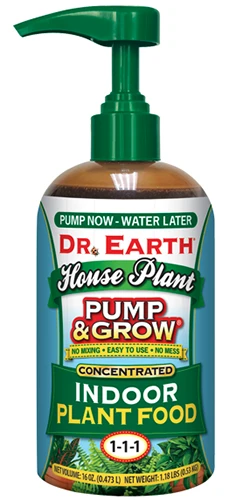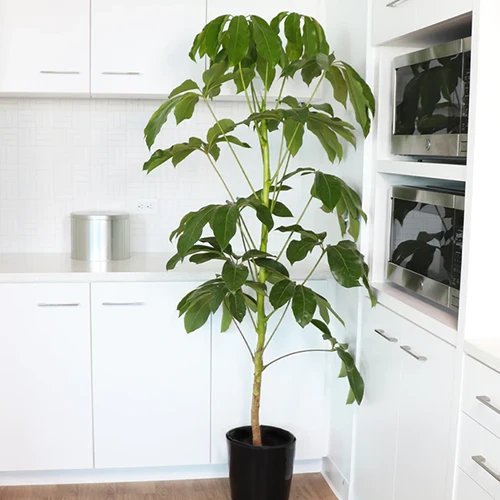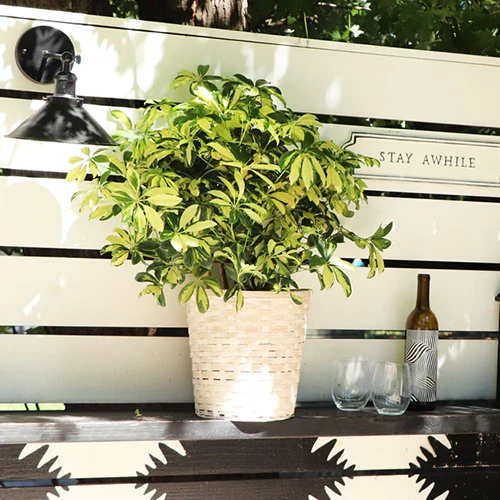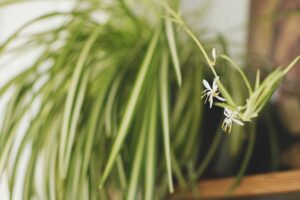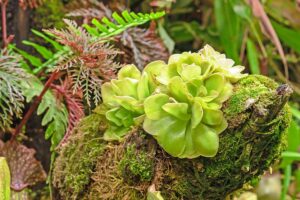Heptapleurum spp. (syn. Schefflera)
Fast-growing, adaptable, and tough, umbrella plants offer up a luscious tropical vibe with no fuss. No wonder you can find them in practically any nursery or houseplant retailer for a song!

We link to vendors to help you find relevant products. If you buy from one of our links, we may earn a commission.
If you’re looking for a houseplant that won’t drive you up the wall with its demands and delicate nature, this is it.
New to houseplants? Want to introduce your kids to raising plants? Pick an umbrella plant. They’re really that easy to care for.
Ready to learn more? Here’s everything we’ll go over. Notice that there’s not a single reference to Rihanna on the horizon…
What You’ll Learn
Parasol plant, octopus tree, umbrella tree – whatever you call it, this classic houseplant has remained a constant favorite for years.
From solid-hued or variegated to dwarf or full-sized species and cultivars, you have all kinds of options to choose from. Let’s talk umbrellas!
Cultivation and History
The first identified species of umbrella plant was described by Hendrik van Rheede, naturalist and administrator of the Dutch East India Company.
He illustrated and described S. venulosa, a vining species, in the 1680s.
When Captain James Cook set out on his famous voyage in 1768, there were fewer than 10 identified species.
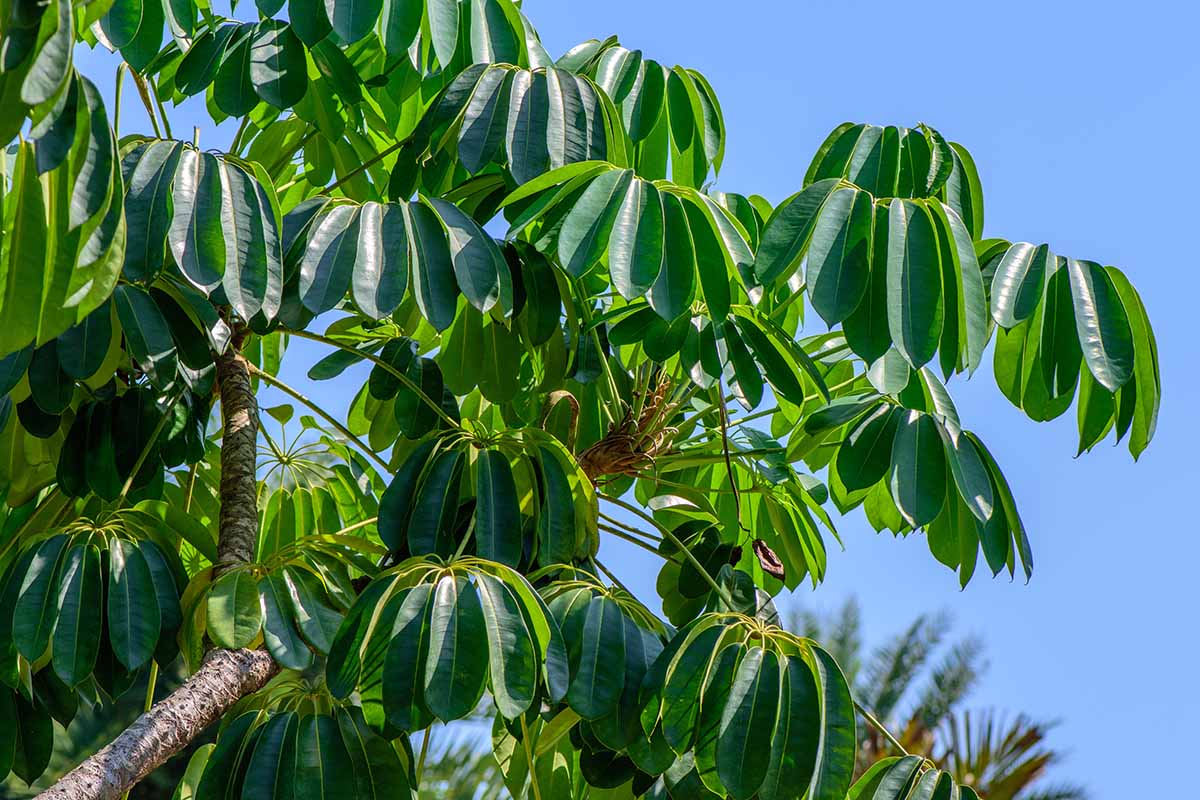
In the 19th century, European explorers started identifying these plants with more regularity. Fast-forward to the mid-1800s and examples were being brought to Europe to be studied and cultivated.
This genus seems as if it’s constantly being reclassified, so hold onto your hat because it’s going to be a bumpy ride to Botanical Taxonomy Town.
Right now, umbrella trees are classified in the Heptapleurum genus.
But most people still know them as Schefflera, named after Jacon Christian Scheffler, a German botanist and physician who practiced in the early 1700s.
Prior to that, they had multiple other taxonomic classifications, including Brassaia.
Whatever we’re calling them this week, these plants are native to Taiwan, South China, Australia, Java, and New Guinea.
There are two common species, H. arboricola, or the dwarf umbrella tree, and H. actinophylla, the standard-sized umbrella tree.
In most areas, dwarf umbrella trees are grown as houseplants indoors, where they usually reach about six to eight feet tall max.
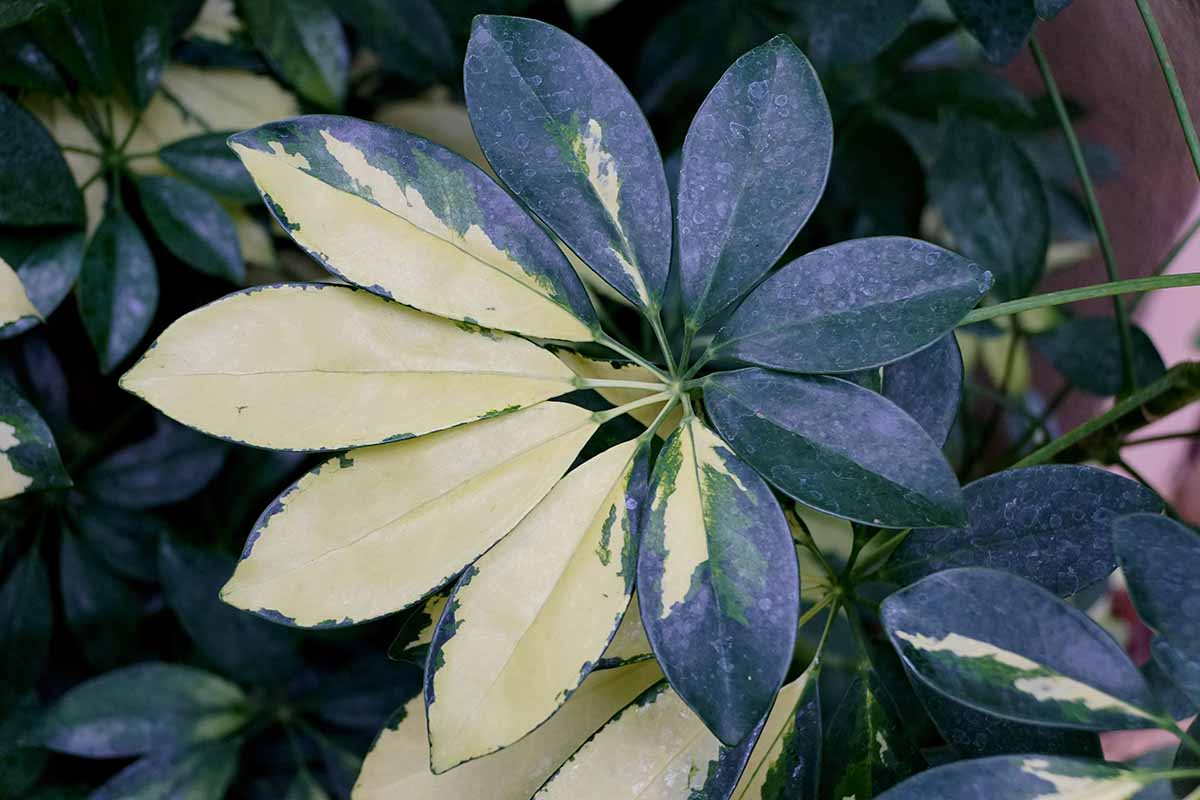
Outdoors in ideal conditions these can reach up to 25 feet tall. The standard-sized species is about double that height outdoors and tops out at about 12 feet indoors.
They also produce clusters of bright yellow flowers when cultivated outdoors, but they rarely bloom indoors.
If you live in USDA Hardiness Zones 10 to 12, you can grow this plant outdoors year-round. Just check your local regulations because umbrella plants can become invasive.
These plants have palmately compound leaves, which means the leaflets radiate from a single central point.
You’ll often hear people call them “palm-like” leaves, as well, because they resemble a human hand with the fingers splayed out.
Umbrella Plant Propagation
On a scale of monstera (easy) to maidenhair fern (not so easy), umbrella trees fall solidly in the monstera end of the propagation spectrum.
They’re easy to propagate from cuttings or via air layering. Seeds are also easy, if slow, assuming that you have access to super fresh ones.
From Seed
It’s entirely possible to grow these plants from seed, but it’s not a reliable option unless you have access to seeds that were recently harvested.
You can usually locate them in places like Hawaii or Florida, where these plants are commonly cultivated outdoors. If you order online, make sure they’re fresh.
The seeds have a fairly low germination rate unless they’re exceptionally fresh. We’re talking under a week or so old. As they age, the germination rate drops dramatically.
Once you have your fresh seeds, place them in warm to hot water (90 to 140°F) and soak for at least 12 hours.
Fill four-inch containers with a fresh, water-retentive, loamy potting mix and sow one seed per container about half an inch deep.
If you want to be super cautious, plant two seeds per container in case one doesn’t germinate.
You can always pluck the weaker seedling out if two grow. Otherwise, just start twice as many pots as you think you’ll need if you have the seeds available to do so.
Water the medium well so it feels moist but not wet. Place the pot in bright, indirect light in a location that stays between 72 and 85°F.
If you live somewhere on the dry side, tent plastic over the container to help retain humidity.
Now, it’s time to hurry up and wait. It takes about a month for the seeds to germinate. During this time, you’ll need to keep the soil moist and don’t let it cool down. If temperatures drop below 72°F for too long, they won’t germinate.
Once the seedlings emerge, either prop up the plastic with a twig or chopstick so the seedlings don’t touch it, or remove it.
Continue to maintain soil moisture. Wait until the plants are a few inches tall before you transplant outdoors or into a larger, decorative pot.
From Cuttings
Many types of houseplants can be propagated by taking cuttings, and umbrella plants are definitely part of this group.
You can do this at any time of year, but the stem that you’re cutting must be at least as thick as a pencil.
Grab some sharp clippers or a grafting knife and wipe it down with soap and water. Take a cutting about four inches in length and cut it at a 45-degree angle.
You also want to make sure you get a growth node, which is the ring on the stem which the leaves emerge from, and at least one leaf.
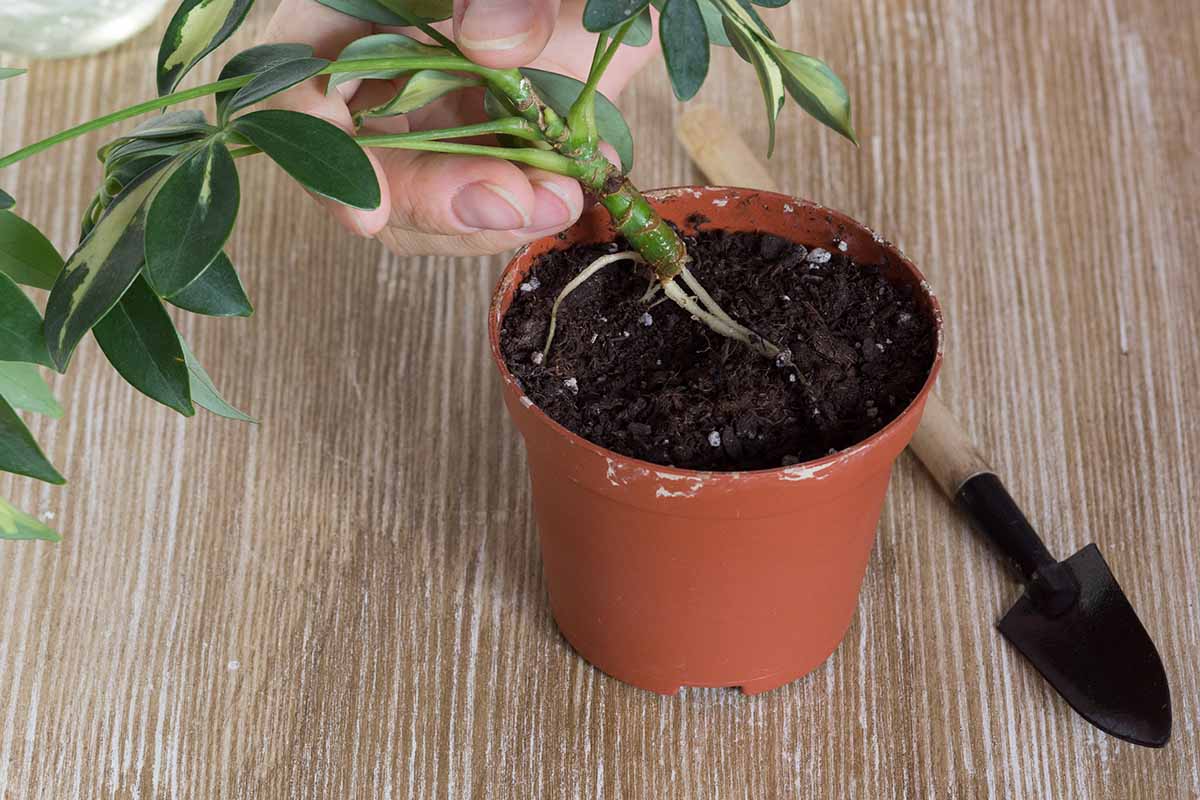
Place the cutting in a three-inch pot filled with moistened seed-starting medium, or in a glass of room-temperature water. The leaf node needs to be submerged.
Keep the cutting in a warm area that is at least 70°F, with bright, indirect sunlight. After a month or so, the cutting should develop roots. In the meantime, your job is to keep the soil moist or change the water every few days to prevent mold.
You’ll be able to see this easily if you’re growing the cutting in water. If you’re growing in soil, give the plant a gentle tug and see if it resists. If so, you’ve got yourself some healthy roots under there!
Now you can transplant your cutting into a permanent pot.
Transplanting Seedlings and Potted Starts
Pretty much anyone selling houseplants carries umbrella trees.
You can nab the more common cultivars for a song. Once you bring yours home, isolate it for a week or so to ensure you’re not bringing any hitchhiking pathogens or pests along.
Whether you’re transplanting seedlings or rooted cuttings that you’ve propagated at home, or repotting nursery starts, the process here is essentially the same.
You don’t want to go up more than one size larger than the pot that the plant came in. An excessively large container increases the risk of root rot. Ensure that it has a hole in the bottom for drainage as well.
Fill your chosen container with a little potting soil. This type of plant enjoys a neutral pH, which is what most pre-mixed potting soils have, so don’t worry about amending the soil.
Take the seedling out of its original pot and knock away as much of the soil from the root ball as possible.
Place the plant at the same depth that it was in the pot. You can bury it just a touch deeper, but don’t bury the stem or you’ll increase the risk of rot.
Water well and let the soil settle a bit. Add more potting soil, if necessary.
Via Air Layering
Air layering is easiest in the spring when umbrella plants are actively growing with a long growing season ahead, but you can also do it in the summer or fall if you like. Just don’t try to air layer plants in the winter when they’re dormant.
To start, take a clean knife and look for an area on the stem between the leaf nodes. Make an inch-long cut, just slicing into the green outer layer but not all the way through into the center.
You want to gently lift up the green outer layer, but leave it attached at one end. Insert a toothpick into the slice that you made to prevent it from closing back up again.
Moisten a handful of sphagnum moss and wrap it around the stem where you made the cut. Wrap plastic wrap over this to hold the moss in place.
Secure at the top and the bottom with twine, zip ties, or string. I like to tape up the bottom but use string at the top so I can open it up and check the moisture level occasionally.
The moss needs to stay moist and the plant should be in a spot with temperatures around 70 to 80°F and bright, indirect light exposure.
Within a month or so, you should start to see roots growing in the moss.
When the plastic is about 50 percent full of roots, cut the stem off below the moss using a clean pair of clippers.
You want to separate the stem from the parent plant, with the new roots attached. Plant it in a container filled with potting medium.
How to Grow Umbrella Tree Houseplants
As with many houseplants, these plants don’t love direct sunlight. However, they will tolerate a bit, just don’t leave them smack dab in the middle of a western-facing window in the summertime.
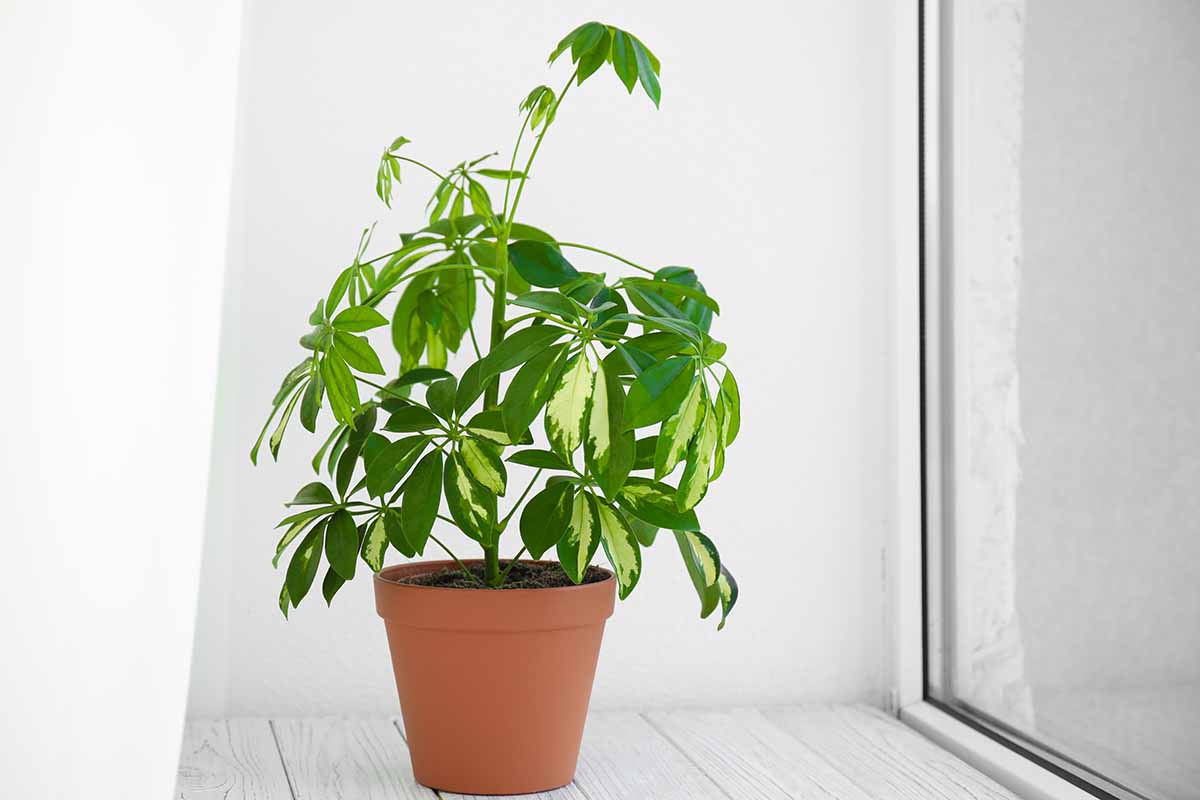
Ideally, give them bright but indirect sunlight like that filtered light you have in front of a south-facing window covered with sheer curtains. Too much shade will cause them to become leggy.
Wherever you place yours, turn it regularly to promote even growth.
If you live in a drafty, poorly insulated home in a region that experiences frigid winters, you’ll want to move this plant away from windows or doors.
Umbrella trees need temperatures above 55°F to be happy, though brief exposure to anything above freezing is fine.
Just as you should err on the side of providing too much sun rather than too little, umbrella trees should be kept on the drier side. They prefer consistently moist soil that dries out an inch deep between watering.
If you stick a finger in the soil and it feels soggy, don’t water. Wait until it feels dry to your first knuckle. That’s the time to add water.
If you’re uncertain, wait. Your plant will be fine with occasional, brief dry spells. But it won’t be okay if it has soggy roots with any regularity.
Umbrella trees aren’t big feeders, but you’ll want to give them a little something every few months from spring through fall. Any mild houseplant fertilizer will do.
Dr. Earth Pump & Grow is a balanced option that’s extremely mild, and it comes with a convenient pump so you can squeeze a little into your watering can and apply it when you do your routine watering.
Pick up 16 ounces at Arbico Organics.
Growing Tips
- Place in bright, indirect light and rotate regularly.
- Keep them away from drafty doors and windows during the cold months.
- Fertilize every two to three months during the growing season.
Pruning and Maintenance
These plants are prone to becoming leggy. Prevention is better than the cure, so keep your plant in bright enough light and rotate it regularly.
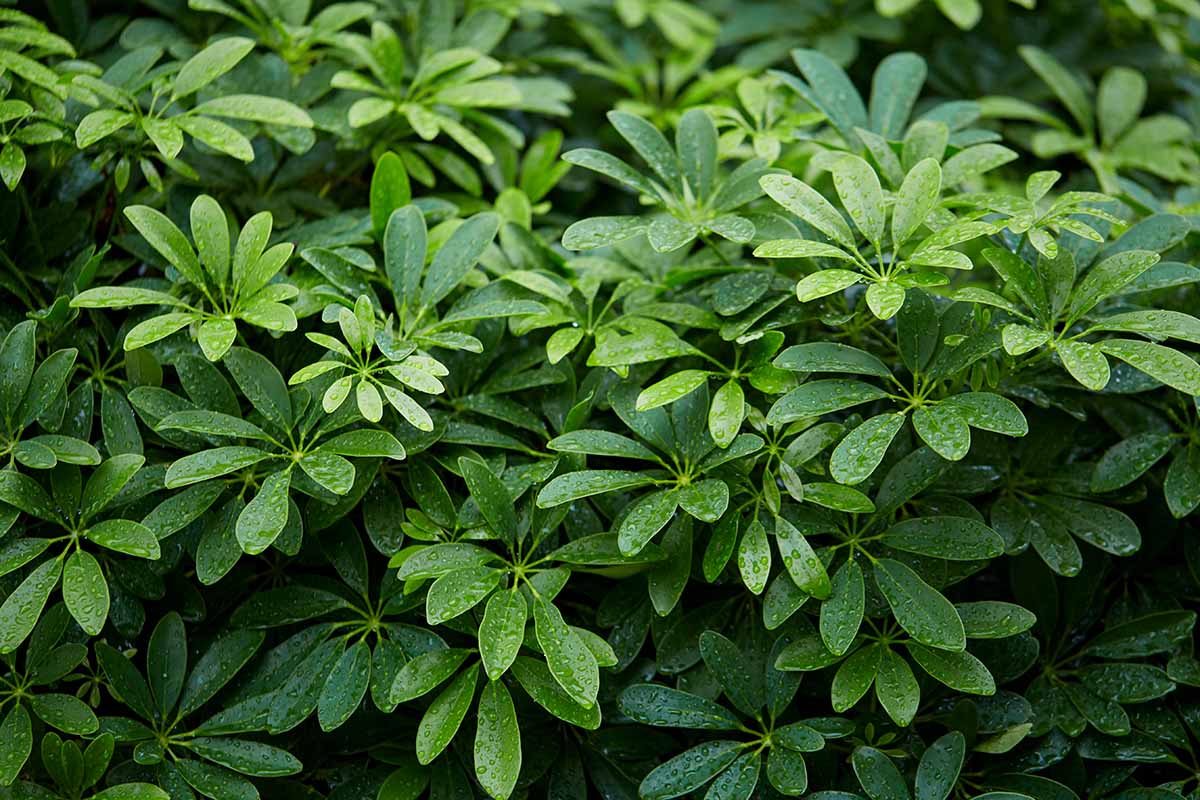
In addition, it really helps to take umbrella trees outside during the warmer months. The changing breezes encourage the plants to develop stronger stems and to put out additional branches.
You might even get some flowers if you let them live outside for a bit!
Umbrella plants can grow outside in Zones 10 to 12 full time, and anywhere else so long as temperatures don’t dip down to 35°F – they’ll be fine if the temperature drops that low one night here or there, but not if it happens with any regularity.
When nighttime temps are above 60°F, they will be perfectly happy.

Indoors, they tend to be a little weaker and more straggly. If your plant becomes a bit leggy despite your best efforts, and the canopy is becoming sparse and thin, prune some of the stems back to about six inches above the soil.
Don’t prune the whole thing all at once. It will probably survive, but it’s better to be safe than sorry. Avoid pruning more than half of the overall growth at a time.
You can also use a stake to provide some support if the plants are becoming large and wobbly to help limit how much you need to prune to keep them under control.
Losing the lower leaves in time is a normal aspect of this plant’s growth habit, giving it a tree-like appearance with an umbrella-shaped canopy.
To encourage bushier growth as the new stuff emerges, pinch the tips every few weeks.
Dust the leaves regularly. It’s an easy chore to forget but it has a major impact on the health of your plant.
Find more umbrella plant pruning tips here.
Species and Cultivars to Select
While there aren’t too many cultivars commonly available (yet), there are some lovely variegated cream or yellow types out there if you’re looking for a little variety.
Actinophylla
This is the original, large-sized species. It can be a bit more difficult to find than the dwarf species and its cultivars.
But if you want a plant that has extremely large leaves and can be grown as an indoor tree, pick this one.
Feeling the big, boldness of it all? Fast Growing Trees carries three- to four- or four- to five-foot-tall trees.
Compacta
‘Compacta’ is an H. arboricola cultivar with a dense growth habit.
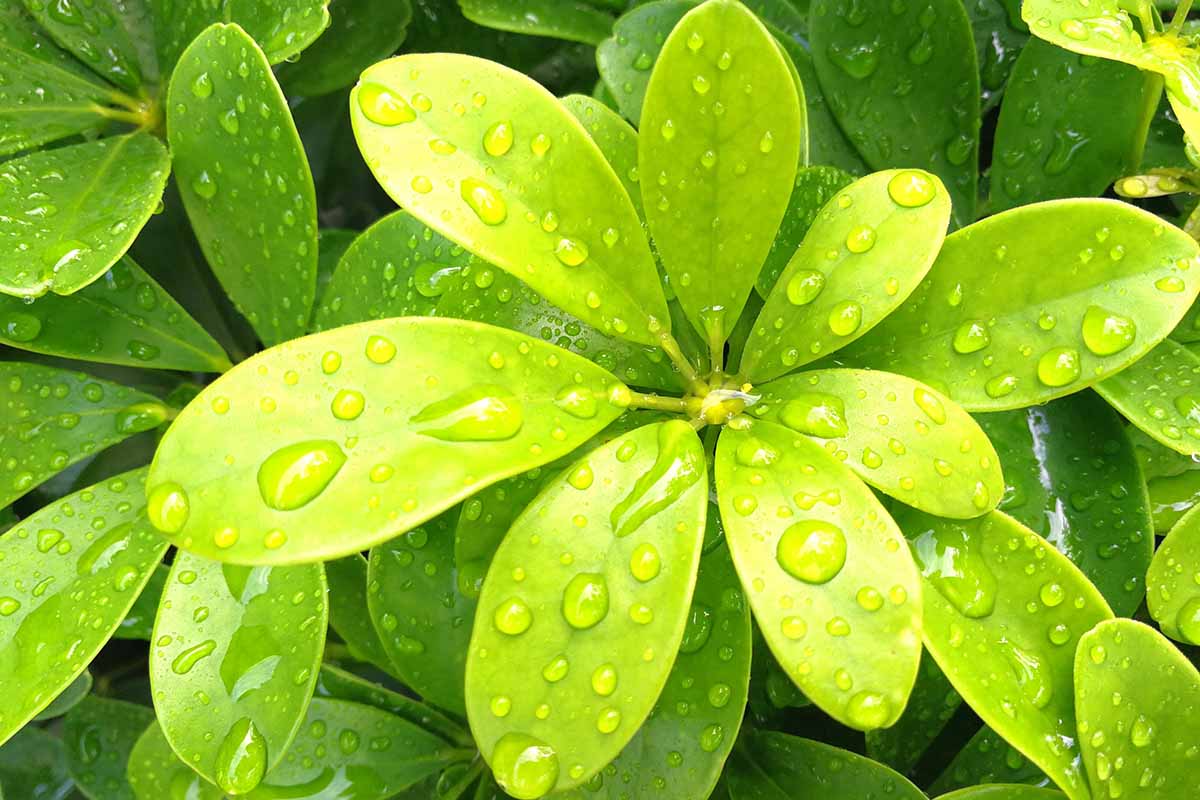
It stays even smaller than its dwarf parent and rarely grows more than four feet tall.
Gold Capella
‘Gold Capella’ is another H. arboricola and another wildly popular option (in addition to the dwarf species) and there’s no mystery as to why.
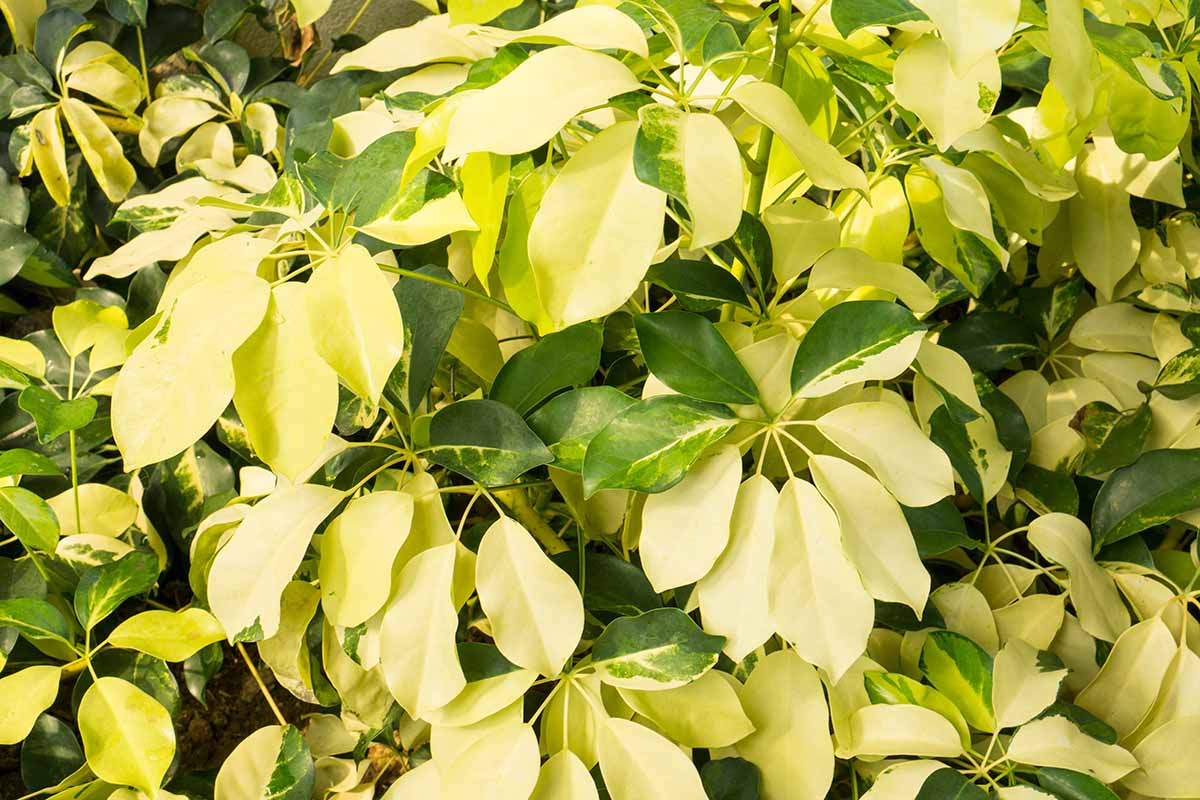
The leaves are dramatically variegated with bright golden-yellow and deep green hues.
Janine
A personal favorite of mine, this H. arboricola cultivar has creamy white variegation on a dwarf plant with petite leaves.
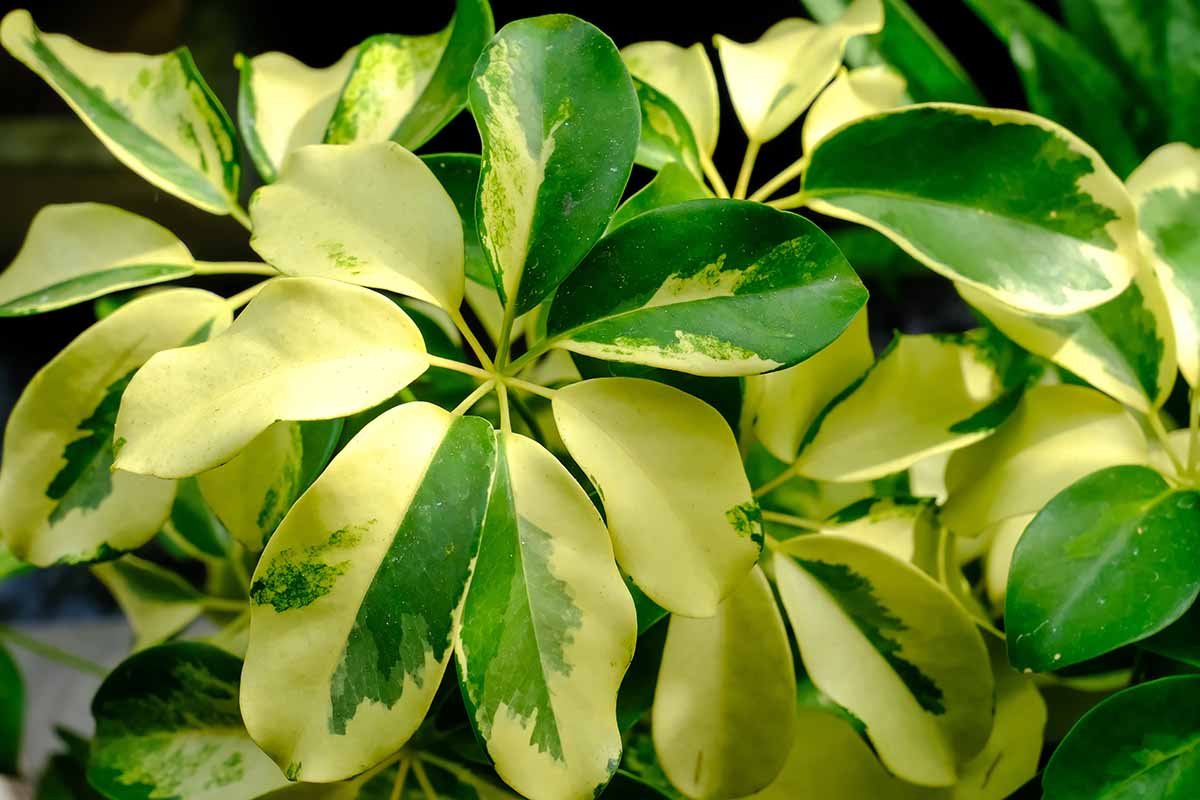
It stays under four feet tall.
Trinette
‘Trinette’ is heavily variegated with yellow, white, and green leaves.
In bright light, some of the leaves of this H. arboricola cultivar might be entirely yellow and white, or nearly so, with splotches of green on the margins.
Bring home a three-foot-tall ‘Trinette’ plant from Fast Growing Trees.
Managing Pests and Disease
Unless they’re stressed by poor environmental conditions like too little light or too much water, umbrella trees are rarely visited by pests or pathogens.
Even when I’ve had pest problems on my houseplants, the uninvited critters fed on apparently tastier species like my alocasias and African violets.
Insects
Nothing unusual to worry about here. Just be on the lookout for these common houseplant pests:
Mealybugs
Mealybugs (family Pseudococcidae) are incredibly common, feeding on all kinds of houseplant species.
While umbrella trees probably aren’t their first choice, they will use their tiny, sap-sucking mouthparts to feed on these plants.
When that happens, it causes the leaves to become discolored with yellow stippling and, if there are enough bugs, growth will be stunted.
These pests are often mistaken for a sign of disease because they move so slowly, and some of them are covered in a waxy, cotton-like coating that looks like a fungus.
You can deal with these pests in the usual manner. That includes hand picking them or trimming badly infested branches off.
Additionally, you can try wiping them with isopropyl alcohol. If all else fails, it’s time to break out the insecticidal soap.
Our guide has more information to help you tackle a mealybug problem.
Scale
Scale insects are wingless little jerks from the order Hemiptera.
Like mealybugs, they use their drinking-straw-like mouthparts to feed on the sap of plants. This feeding turns the leaves yellow and makes the plant wilt and droop.
They can vary in appearance depending on whether they’re armored or soft, but they’re generally oval-shaped and somewhat flat. They move slowly and tend to cluster in groups.
If you catch an infestation quickly, you can just take a butterknife and gently scrape them off into a bowl of soapy water. For more tips, read our article on dealing with scale.
Spider Mites
If you notice your plant looking dry and the leaves appear to be kind of stippled yellow and sad, examine your plant closely. You might see lots of fine webbing on the leaves and stems.
This webbing will likely be filled with little dots, which are the cast-off exoskeletons of spider mites.
Spider mites like dry conditions. If you keep your plant moist and humid, you’ll rarely have to worry about them. But they’re pretty common, so never say never!
If you notice the tell-tale signs of these pests, read our guide to managing spider mite infestations to learn how to cope.
Disease
More often than not, you’ll run into problems caused by the wrong environmental conditions rather than disease. In fact, indoor plants rarely experience infections.
But there are environmental issues like too much water or low temperatures that can cause problems.
For instance, if a branch suddenly turns black and falls off, it’s probably due to cold damage.
Maybe you accidentally left the plant outside on a chilly night or the heat was turned off. Within a week, exposure to low temperatures causes the leaves to turn black, shrivel up, and fall off.
So long as the roots didn’t die, new growth will replace the stuff that fell off. Just give it time and trim off any of the dead stuff.
Too much water, on the other hand, simply drowns the roots, suffocating them. Root rot may sometimes involve a bacterial or fungal pathogen, but not always.
The plant will wilt and the leaves will start to turn black, beginning at the tips. Back off with the watering and make sure the drainage hole in your pot isn’t blocked.
Best Uses for Umbrella Plants
Most people just let their umbrella plant stand out as a specimen either indoors or outside in a container.
You can also use them to make bonsai. Or, get creative and use yours as a backdrop for some vining or shorter plants.
Quick Reference Growing Guide
| Plant Type: | Tropical evergreen tree | Flower/Foliage Color: | Yellow/green, yellow, white, variegated |
| Native to: | Australia, Java, New Guinea, South China, Taiwan | Maintenance: | Low |
| Hardiness (USDA Zones): | 10-12 | Tolerance | Some drought |
| Bloom Time/Season: | Evergreen (summer blooms outdoors) | Water Needs: | Moderate |
| Exposure: | Partial sun or partial shade (outdoors); bright, indirect light (indoors) | Soil Type: | Loamy |
| Time to Maturity: | Up to 30 years outdoors | Soil pH: | 6.0-7.0 |
| Planting Depth: | 1/2 inch (seeds), same as container (transplants) | Soil Drainage: | Well-draining |
| Height: | Up to 8 feet indoors | Family: | Araliaceae |
| Spread: | Up to 6 feet indoors | Genus: | Heptapleurum syn. Schefflera |
| Common Pests and Diseases: | Mealybugs, scale, spider mites; root rot | Species: | Canadensis, chinenis, occidentalis, siliquastrum |
Umbrella Trees Are the Ultimate Easy Houseplants
With their tropical vibes and easy-going nature, umbrella plants have earned a place in the houseplant hall of fame.

Is this your first time growing this type of plant? Or are you here looking for new ideas to help your plant thrive? Fill us in below, in the comments section.
Where one houseplant is good, many are better. If you want to expand your indoor jungle, these guides can help make it happen:
